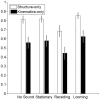The effect of looming and receding sounds on the perceived in-depth orientation of depth-ambiguous biological motion figures
- PMID: 21373181
- PMCID: PMC3044128
- DOI: 10.1371/journal.pone.0014725
The effect of looming and receding sounds on the perceived in-depth orientation of depth-ambiguous biological motion figures
Abstract
Background: The focus in the research on biological motion perception traditionally has been restricted to the visual modality. Recent neurophysiological and behavioural evidence, however, supports the idea that actions are not represented merely visually but rather audiovisually. The goal of the present study was to test whether the perceived in-depth orientation of depth-ambiguous point-light walkers (plws) is affected by the presentation of looming or receding sounds synchronized with the footsteps.
Methodology/principal findings: In Experiment 1 orthographic frontal/back projections of plws were presented either without sound or with sounds of which the intensity level was rising (looming), falling (receding) or stationary. Despite instructions to ignore the sounds and to only report the visually perceived in-depth orientation, plws accompanied with looming sounds were more often judged to be facing the viewer whereas plws paired with receding sounds were more often judged to be facing away from the viewer. To test whether the effects observed in Experiment 1 act at a perceptual level rather than at the decisional level, in Experiment 2 observers perceptually compared orthographic plws without sound or paired with either looming or receding sounds to plws without sound but with perspective cues making them objectively either facing towards or facing away from the viewer. Judging whether either an orthographic plw or a plw with looming (receding) perspective cues is visually most looming becomes harder (easier) when the orthographic plw is paired with looming sounds.
Conclusions/significance: The present results suggest that looming and receding sounds alter the judgements of the in-depth orientation of depth-ambiguous point-light walkers. While looming sounds are demonstrated to act at a perceptual level and make plws look more looming, it remains a challenge for future research to clarify at what level in the processing hierarchy receding sounds affect how observers judge the in-depth perception of plws.
Conflict of interest statement
Figures


Similar articles
-
Auditory motion in depth is preferentially 'captured' by visual looming signals.Seeing Perceiving. 2012;25(1):71-85. doi: 10.1163/187847611X620928. Seeing Perceiving. 2012. PMID: 22353569
-
Hearing brighter: changing in-depth visual perception through looming sounds.Cognition. 2014 Sep;132(3):312-23. doi: 10.1016/j.cognition.2014.04.011. Epub 2014 May 22. Cognition. 2014. PMID: 24858108
-
Asymmetries in behavioral and neural responses to spectral cues demonstrate the generality of auditory looming bias.Proc Natl Acad Sci U S A. 2017 Sep 5;114(36):9743-9748. doi: 10.1073/pnas.1703247114. Epub 2017 Aug 21. Proc Natl Acad Sci U S A. 2017. PMID: 28827336 Free PMC article.
-
The facing bias in biological motion perception: structure, kinematics, and body parts.Atten Percept Psychophys. 2011 Jan;73(1):130-43. doi: 10.3758/s13414-010-0018-1. Atten Percept Psychophys. 2011. PMID: 21258915
-
Action-specific influences on perception and postperceptual processes: Present controversies and future directions.Psychol Bull. 2015 Nov;141(6):1120-44. doi: 10.1037/a0039738. Psychol Bull. 2015. PMID: 26501227 Free PMC article. Review.
Cited by
-
Audiovisual correspondence facilitates the visual search for biological motion.Psychon Bull Rev. 2023 Dec;30(6):2272-2281. doi: 10.3758/s13423-023-02308-z. Epub 2023 May 25. Psychon Bull Rev. 2023. PMID: 37231177 Free PMC article.
-
Bodily movement of approach is detected faster than that of receding.Psychon Bull Rev. 2012 Oct;19(5):858-63. doi: 10.3758/s13423-012-0284-0. Psychon Bull Rev. 2012. PMID: 22715025
-
Facilitating masked visual target identification with auditory oddball stimuli.Exp Brain Res. 2012 Aug;221(2):129-36. doi: 10.1007/s00221-012-3153-1. Epub 2012 Jul 4. Exp Brain Res. 2012. PMID: 22760584 Clinical Trial.
-
Cross-modal social attention triggered by biological motion cues.J Vis. 2020 Oct 1;20(10):21. doi: 10.1167/jov.20.10.21. J Vis. 2020. PMID: 33112938 Free PMC article.
-
Further explorations of the facing bias in biological motion perception: perspective cues, observer sex, and response times.PLoS One. 2013;8(2):e56978. doi: 10.1371/journal.pone.0056978. Epub 2013 Feb 27. PLoS One. 2013. PMID: 23468898 Free PMC article.
References
-
- Gallese V, Keysers C, Rizzolatti G. A unifying view of the basis of social cognition. Trends in Cognitive Sciences. 2004;8:396–403. - PubMed
-
- Johansson G. Visual perception of biological motion and a model for its analysis. Perception & Psychophysics. 1973;14:201–211.
-
- Blake R, Shiffrar M. Perception of human motion. Annual Review of Psychology. 2007;58:47–73. - PubMed
-
- Verfaillie K. Perceiving human locomotion: Priming effects in direction discrimination. Brain and Cognition. 2000;44:192–213. - PubMed
-
- Beauchamp MS, Lee KE, Haxby JV, Martin A. Parallel visual motion processing streams for manipulable objects and human movements. Neuron. 2002;34:149–159. - PubMed
Publication types
MeSH terms
LinkOut - more resources
Full Text Sources

